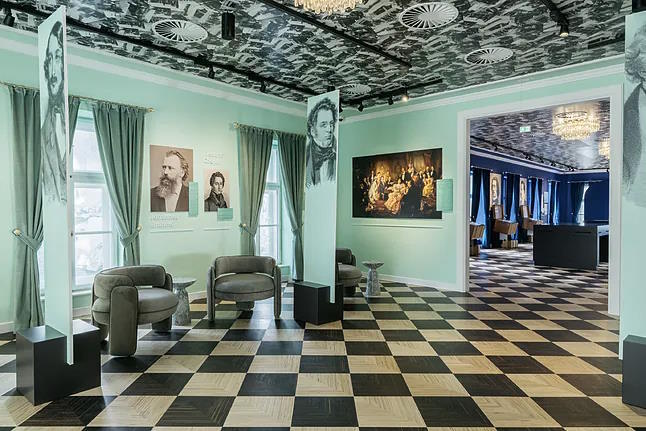Anniversaries, capital cities, events, celebrations... The list of reasons to visit certain destinations during this just-started 2025 multiplies across the planet. From Vienna, celebrating in a big way the year of one of its most acclaimed composers, Johann Strauss II, to Vilnius, European Green Capital. These are just two examples of the places that will be most talked about over the next 12 months.
When talking about waltzes, one talks about The Blue Danube and about its author, Johann Baptist Strauss II (or Strauss Jr.), whose figure is remembered this year due to the bicentennial of his birth in the Viennese district of Neubau. That is why the Austrian capital pays tribute to him with a thousand activities, starting with the New Year's concert, which usually features his creations. And this time, more than ever. The tribute continues at the Strauss House, where he enjoyed his other passions besides music: tarot, billiards, and drawing caricatures. These are reflected in the building, which includes an interactive exhibition about the Strauss family, as well as displaying violins, pianos, the artist's own death mask, and even a ballroom.
The Theater Museum, on the other hand, hosts the largest exhibition about the author, Celebrating Johann Strauss, until June 23, while the Sound Museum offers the opportunity to conduct The Blue Danube with the help of a virtual conductor. Each week of the Strauss Year will bring new premieres, whether they are plays, concerts, or digital art at various points in the capital. Themed days have also been organized, such as the bat (the name of another of his famous waltzes) on April 5 or the author's birthday on October 25. More information at wien.info
TARRAGONA, 25 YEARS AS HERITAGE
The next protagonist in the ranking is Tarragona, commemorating its 25th anniversary as a World Heritage City. To remember this, it offers a journey through its history to recall what the Roman Tarraco was like back in the 2nd century, its period of greatest splendor, through a mapping and a 1:500 scale model located in the Pallol square. The walk through time continues through its walls (of which 1.1 kilometers, 30% original, are preserved), its provincial forum, its Archaeological Museum, its circus, or its amphitheater, with a capacity for 14,000 spectators.
The nature and sea culture, with its idyllic beaches with turquoise waters, are also icons of the Catalan city, as well as its gastronomy. One of its most important fairs is Tarraco a Taula (May), within the Tarraco Viva Festival, which recreates what military and daily life was like in Roman times, with dishes inspired by that era. Not to be missed is its star product, romesco sauce, perfect for accompanying fish, vegetables, and meats and made with products from the Mediterranean diet such as olive oil, roasted tomatoes, or toasted almonds and hazelnuts. More information at tarragonaturisme.cat
EUROPEAN CAPITALS OF CULTURE
Last year, three cities held the title (Bad Ischl in Austria, Bodø in Norway, and Tartu in Estonia) and this year two will do so: the German city of Chemnitz and the Slovenian city of Nova Gorica. Both have been selected for their commitment to improving the cultural life of their inhabitants, intertwining it with their history. Thus, over the next few months, both will be the stage for countless activities, events, festivals, and exhibitions, in addition to exploring the region's future and its connection with the rest of Europe.
The German city of Chemnitz at sunset.VISIT CHEMNITZ
In this sense, the first, called the city of modernity for its leadership in the industrial field, will showcase its potential in places like the Opera Theater, the Gunzenhauser Museum, or the New Saxon Gallery. On the other hand, Nova Gorica, known as the city of roses, stands out for its border location between Slovenia and Italy, becoming the first European Capital of Culture without borders. More information at culture.ec.europa
Within the Old Continent, the European Green Capital is also reviewed. This year, the Lithuanian city of Vilnius has been chosen, replacing Valencia. Its environmental commitment and policies to transform an urban environment into a sustainable space are to blame. The designation not only rewards the achievements but also encourages further efforts in its ecological approach, as its goal is to achieve climate neutrality by 2030.
To achieve this, the city will launch more initiatives in renewable energies and healthy living, involving the new generations. Additionally, throughout the year, there will be events related to the green spirit such as awareness days, exhibitions, workshops, marathons, organic gastronomy fairs, city tours, and thematic weeks like the climate week. More information at govilnius.lt
THE LITERARY FACE OF RIO DE JANEIRO
Returning to capital cities, Rio de Janeiro will be the World Book Capital after taking over from the French city of Strasbourg in this title granted by Unesco to promote "positive impact on society through the promotion of literacy, education, and the fight against poverty," in the words of Audrey Azoulay, the organization's director-general.
Therefore, starting on April 23 (World Book Day), the Brazilian city (the first Portuguese-speaking one to be chosen) will be the focus of a multitude of cultural activities developed by entities such as the Brazilian Academy of Letters, the National Library, the Royal Portuguese Reading Room, the Book Fair, or the Peripheral Literary Festival. Among them are educational programs, conferences, discussions, fairs, meetings with writers, reading circles, and performances. More information at visitbrasil.com
